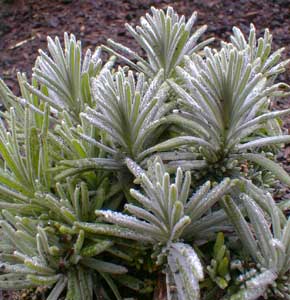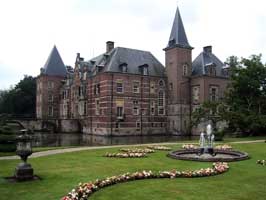
'Twickel Purple'
English Lavender
"Such special sweetness was about
That day God sent you here,
I knew the lavender was out,
And it was mid of year."
-Lizette Woodworth Reese
(1856-1935)
(1856-1935)
Shown here is a tight little clump of what is possibly the most cold-hardy of all lavenders, Lavandula angustifolia 'Twickel Purple.' It's shown as a newly planted little ball of surprisingly compact foliage, uniquely arranged as interwoven fans of fatter-than-normal leaves. It can someday grow two feet wide & at least a foot tall, plus another foot of flower spikes. In height it just qualifies as a dwarf lavender.
Not only are the spikes of flowers a deeper shade of lavender-purple than most cultivars, but the evergreen foliage takes on a purplish hue in winter.
This is a hardy old variety sometimes sold as 'Nana Compacta' or just 'Compacta,' because the blue-green foliage is unusually compact & dome-shaped, rarely much more than a foot tall if flower spikes are discounted.
This recipient of the Award of Garden Merit sometimes has its name shortened from 'Twickel Purple' to simply 'Twickel,' 'Twickle,' or 'Twikkel,' or given the shortened pet-name 'Twickes.' It is occasionally completely incorrectly labeled in the United States as 'Munstead' which is actually a different variety without the fan-like arrangement of flatter leaves.
Being such an old cultivar, with several growers, there can be considerable variation in appearance, & five forms of 'Twickel' are known, each set apart by the fan-shaped leaves & the fact that leaves & flowers are bigger than normal but as a shrub it is shorter & tighter than other cultivars.
 Although the correct name is 'Twickel' ours came with a full-color label which called it 'Twinkle Purple,' & the error is so common that 'Twinkle' has become an acceptable alternative spelling. But its name was not intended to invoke some image of a twinkling shrub, for it is named for Twickel Castle in Holland (shown in photo at right), where this lavender was first grown.
Although the correct name is 'Twickel' ours came with a full-color label which called it 'Twinkle Purple,' & the error is so common that 'Twinkle' has become an acceptable alternative spelling. But its name was not intended to invoke some image of a twinkling shrub, for it is named for Twickel Castle in Holland (shown in photo at right), where this lavender was first grown.Though now generally accepted to be a sport of L. angustifolia, some do believe it should be categorized L. intermedia, meaning it could be the hybrid L. angustifolia x latifolia such as are called Lavandins. Lavandin was originally developed for increased production of oil, but select forms were later chosen for interesting ornamental qualities.
Because Twickes is so cold-hardy, it is grown in some chilly zones where its bloom time is abbreviated to June or July only. In zones 7 & 8 it should bloom all summer.
It has an excellent scent devoid of of the camphoriness of some lavenders, so that 'Twickes' is a popular crop-variety for obtaining extracts used in candies. The scent is best & srongest when grown in poorer soil. It will get leggy in humusy soil & not live as many years. In poor soil it stays tidier with no loss of bloom power, but even so will need a hard sheering after it is done blooming, or it may over time lose its unusually compact appearance.
English Lavenders are simply such useful garden inhabitants, & we have several cultivars in addition to 'Twickle Purple,' including 'Hidcote' & 'Goldberg', besides sundry Spanish Lavenders.
Lavender flowers are long-lasting in bouquets & are the best air-fresheners. Dried flowerheads, including even spent deadheaded ones, hold their scent a very long time, & can be crunched up for sachets.